Photo albums from this trip are here.
In August 2010 we went to Russia (with a short side trip to Mongolia). Most of the trip was on the Golden Eagle Trans Siberian Express, a private train owned by GW Travel, a UK company. Our tour was organised by Travelrite, an Australian company.
This page is a very brief summary of the first part of the trip. We intend to return and fill in more details when we find time.
On Wednesday, 4 August, we flew from TownsÂville to Brisbane to Singapore to Incheon (Korea), with longish waits between flights. In Brisbane we had to collect our baggage and take it on the train to the international terminal. Even at $5 each, the train beats anything else unless you have a big family, lots of luggage, or mobility problems.
We discovered the Secure Wrap people at the international airport wrapping bags. They say they’ve been there for several years, but we hadn’t noticed them before. Cost $20 for the two duffle bags, but may be a good idea. Luggage straps getting caught in a conveyor belt can make a nasty end to a bag. Plus theft is the security aspect. We did this, just like Jean did on her South American trip.
We had several hours at Brisbane airport before our flight to Singapore. We sat in a reasonably comfortable area of Brisbane International until the ticket area opened for our Singapore Airlines flight. Business class meant a short queue. We headed for the business lounge to relax before the flight. Power connections and free WiFi, as well as welcome snacks and drinks. Not much snacking, as business class typically means you get well fed. We were in Business Class for all our international flights (except Incheon to Vladivostok), so we could enjoy the Singapore lounges’ copious and delicious food, their free wifi, and their showers.
While waiting, we wandered around the duty free shops. Eric bought a Panasonic Lumix TZ10 GPS enabled small 12 times ultra zoom camera, which had been getting good reviews for its lens and other features. Now that so many photo storage systems can handle GPS, Eric wanted to start using it from more cameras than just his iPhone. He bought it at a better price than at JB HiFi and close to the Retravision sale price.
We flew Brisbane to Singapore (Changi) in business class on Singapore Airlines SQ236 (an Airbus A330-300), about an 8 hour flight, much of it getting across Queensland and the Northern Territory. The plane was not as large as we expected. We had excellent service in business class.
In Singapore we had several hours at the Changi airport, where we took a walk through the gigantic Terminal Three. That was almost long enough to be real exercise. We connected with fellow tour members from Australia, who had arrived on various flights from Sydney, Melbourne, and Perth; all were on the same flight to Korea, though most were back in Economy. Singapore Airlines SQ602 (an Airbus A330-300) departing 11:55 p.m. on an 6 hour 25 minute flight.
Arrived in Incheon near Seoul on Thursday, 5 August, around 7:30 a.m. This airport was another gigantic new one. We seemed to walk forever. Immigration was efficient, once our line reached it. Baggage worked well. Customs a breeze. We milled around at arrivals, gradually accruing the other members of our tour party. and met our tour leaders Neville and Sandra Walliss (founders and managing directors of Travelrite).
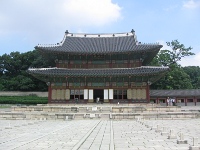

After an hour’s drive in a tour bus, we droped off our luggage at the Sheraton Incheon and then were taken on a guided sightseeing tour of Seoul. We visited the World Heritage listed (in 1997) Changdeokgung Palace and its large traditional gardens set in 45 hectares of park. Built in 1405 by King Taejong as a secondary palace to nearby Gyeongbokgung Palace (established 1395), the palace was burned down during the time of the Japanese Invasion of Korea in 1592. Angry citizens set fire to the palace when it was evacuated during the time of invasion. Thanks to King Gwanghaegun, the palace was later restored in 1609. Changdeokgung was the principal palace for many of the Joseon Dynasty kings, and is the best preserved among the five remaining royal Joseon palaces. Eric wanted to see the ondol, the heating system. Traditionally, Korean houses were heated by generating heat under their floors, and there is an example here.

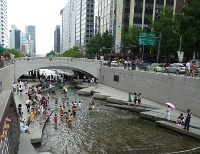 Next was a guided tour of part of the 6-kilometre Cheonggyecheon Stream. This former road covering a river through the middle of Seoul was restored to a stream over a 3-year period. It opened on 1 October 2005 at a cost of 370 billion Won. There are over twenty bridges spanning the stream. What a pity Sydney does not try something that audacious!
Next was a guided tour of part of the 6-kilometre Cheonggyecheon Stream. This former road covering a river through the middle of Seoul was restored to a stream over a 3-year period. It opened on 1 October 2005 at a cost of 370 billion Won. There are over twenty bridges spanning the stream. What a pity Sydney does not try something that audacious!
Visited a department store and market for lunch. The place was fairly upmarket, but not knowing the language made identifying some items difficult. Wandered a lot. Back to hotel, a one hour drive.
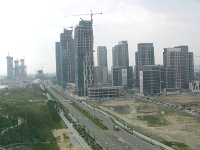 Incheon is essentially a brand new city. Amazing sight from the Sheraton. The crane index was high: we could see five from our bedroom window. On one bus drive seventeen cranes were visible on the skyline. Next door almost is the vacant lot that will become the highest building in South Korea, 310 metres. The existing building next door is sufficiently impressive.
Incheon is essentially a brand new city. Amazing sight from the Sheraton. The crane index was high: we could see five from our bedroom window. On one bus drive seventeen cranes were visible on the skyline. Next door almost is the vacant lot that will become the highest building in South Korea, 310 metres. The existing building next door is sufficiently impressive.
The night view from our room is wonderful, seeing an entire city being brought to life around us. We didn’t discover until the next morning, as we were waiting to leave, that the hotel’s Business Centre had free wifi.
On Friday, 6 August, after getting up much too early for a full buffet breakfast and the hour’s drive to the airport for checkin two hours before our flight, we flew to Vladivostok on Korean Air KE985. Our group were all down the back; we were in row 48 of 49 for the 2+ hour flight.
When we set down there was a delay in getting out of the plane, then we spent over an hour waiting to pass through Russian immigration. The space available for the immigration queue was too small for the number of people on the plane, and the queues moved very slowly because the immigration agents were entering passport info manuÂally. The queue we were in was so slow we thought we must encounter a hulking monolith ready to argue with anyone. Instead it was a petite Russian woman in an imposing uniform, who went straight to work entering information.
We were nearly the last out. When we emerged in the baggage area, there were only about four bags still on the baggage conveyor. Then they got an XRay, but the sniffer dogs did not seem to care much. A new terminal building is under construction. That should solve the space problem, but it won’t solve the problem of slow processing unless the passport control systems are also updated.
We were met by Olga and Tatyana and taken by bus to the Hotel Hyundai. Olga was on our bus. She did a great job of describing the scenes on the hour-long drive to the traffic madness of Vladivostok (ВладивоÑток). We drove along a highway created for when US President Ford was visiting. Still in good condition. The city will get new infrastructure, including a new airport. This is for an Asia Pacific international conference to be held in 2012 on Ruskii Island, the largest island in the beautiful harbour. There are also three more 5-star hotels to be built around the city. The city is hilly, like a Russian version of San Francisco. There is a lot of commerce with China, which has cheaper goods. The Chinese come for the gambling.
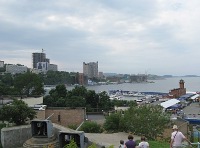
 The hotel has wonderful views of the harbour, where we could see some Soviet era warships. Unfortunately the weather was hot (30C) and the humidity very high. The lobby smells of cigarette smoke, and there was an ash tray in the bathroom. The mini bar in the room even had cigarettes for sale, along with vodka and condoms. The fire escape system was a bag containing harness, ropes, and other gear for rappelling down the side of the building. All very James Bondish.
The hotel has wonderful views of the harbour, where we could see some Soviet era warships. Unfortunately the weather was hot (30C) and the humidity very high. The lobby smells of cigarette smoke, and there was an ash tray in the bathroom. The mini bar in the room even had cigarettes for sale, along with vodka and condoms. The fire escape system was a bag containing harness, ropes, and other gear for rappelling down the side of the building. All very James Bondish.
We collapsed until 6PM, when we met the group in the lobby for our bus trip to the welcome dinner at the Versailles Restaurant on the third floor in the oldest hotel in town. It was not far from our hotel, but the one way streets in this hilly city made progress interesting. There we met the other train passengers, who had arrived from North America and Europe. The 30 Australians made up about half of the passengers.
The restaurant was most interesting, in a wonderful room. We were plied with drinks, met some of the other GW Travel train staff and our travelling doctor Elaine. We did not return to the hotel until after nine. I don’t think we managed to get all the lights and power points working until the morning.
On Saturday, 7 August, we had a leisurely 10:45AM start. Eric was out early, walking to the waterfront a few blocks away to see the warships. The very thought of being allowed to be wandering around the former Russian Pacific fleet city is simply amazing. Being able to freely take photographs (albeit mostly of monuments) was even more amazing. Dodging the traffic while attempting to cross streets was likewise amazing. We learned that vehicular traffic has right of way, even at pedestrian crossings. To make it more interesting, secondhand right drive cars from Japan are cheaper. So drivers on the right hand side of the road are using right hand drive vehicles. It looked like murder!
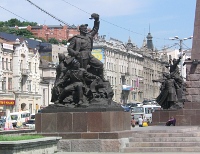 We were taken on a tour of Vladivostok before boarding the train: several lookouts, old fortifications, the waterfront, a submarine, various churches. The town looks gray and tired, but much refurbishment and new construction (including the new terminal at the airport and a new road from the airport to the city) is underway. They are also building a impressive bridge across to Ruski Island for the Asia Pacific international conference in 2012.
We were taken on a tour of Vladivostok before boarding the train: several lookouts, old fortifications, the waterfront, a submarine, various churches. The town looks gray and tired, but much refurbishment and new construction (including the new terminal at the airport and a new road from the airport to the city) is underway. They are also building a impressive bridge across to Ruski Island for the Asia Pacific international conference in 2012.
We drove past former amusement park sites made from a former cemetery, following a period when cathedrals were destroyed. Past the medical university. We went through Pigeon Valley, named after the carrier pigeons the military once used. We reached the Eagles Nest, highest point in town. As well as having splendid views, it is a popular spot for weddings. Indeed, weddings were popular at every tourist spot we visited. From the viewpoint we could see in the far distance the coal fired power station for the area. It is slated to be eventually converted to gas.
There is a monument to the priests who devised the Cyrillic alphabet, Saints Cyril and Methodius. A whole bunch of languages are written with the Cyrillic alphabet (derived from the Greek alphabet around the 9th Century), including Bulgarian, Chechen (reluctantly), Kurdish, Macedonian, Mongolian, Russian, Serbian (officially), Tatar, Ukrainian, and at least fifty others. The alphabet achieved its current westernised letter form in 1708 during the reign of Peter the Great. Four letters were eliminated from the alphabet in a 1917/18 reform, bringing the number of letters down to 33: 11 vowels, 20 consonants and 2 letters which do not have a sound (instead they make the word harder or softer).
We visited several chapels with golden roof, one near the submarine S56 museum and memorial to lost sailors. Four section of the submarine are empty of equipment but full of exhibits, while three are restored to their wartime state. Sure was cramped. Good idea to show us that before we reached the train. The area also had the St Andrews chapel, this being the patron saint of sailors. It was also interesting to see nearby a rather dilapidated tall building that was once the headquarters of the Soviet First Pacific Fleet.
Another lookout was one of many buried fortresses, with earth ramparts and a variety of underground heavy guns. The Russians were making sure their beautiful harbour and its city were protected from invasion by sea.
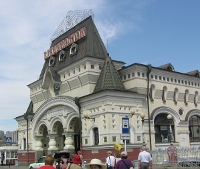
 The railway station is full of artwork (sculptures and paintings). We photographed each other at the end marker for the Trans Siberian Railway. We met Katrina, one of our car attendants, at the door of the carriage as she helped us board. Our bags were already in our cabin, occupying most of the available floor space. We unpacked into the many small, not always convenient, storage spaces in our comfortable cabin. A wide and deep but not very high open space above the door, and spreading into the ceiling space above the corridor. A two level wardrobe, with hanging space for a half dozen or more clothes hangers. Another cupboard above that, albeit hard to reach without the ladder. Eric went to the bar car while Jean unpacked. The train departed Vladivostok in the late afternoon.
The railway station is full of artwork (sculptures and paintings). We photographed each other at the end marker for the Trans Siberian Railway. We met Katrina, one of our car attendants, at the door of the carriage as she helped us board. Our bags were already in our cabin, occupying most of the available floor space. We unpacked into the many small, not always convenient, storage spaces in our comfortable cabin. A wide and deep but not very high open space above the door, and spreading into the ceiling space above the corridor. A two level wardrobe, with hanging space for a half dozen or more clothes hangers. Another cupboard above that, albeit hard to reach without the ladder. Eric went to the bar car while Jean unpacked. The train departed Vladivostok in the late afternoon.
Dinner with Neville and Sandra, our tour organisers. Amongst other things, we discussed iPad and how to get more eBooks. In our carriage, three out of the four couples were carrying an Apple iPad for their notes.
